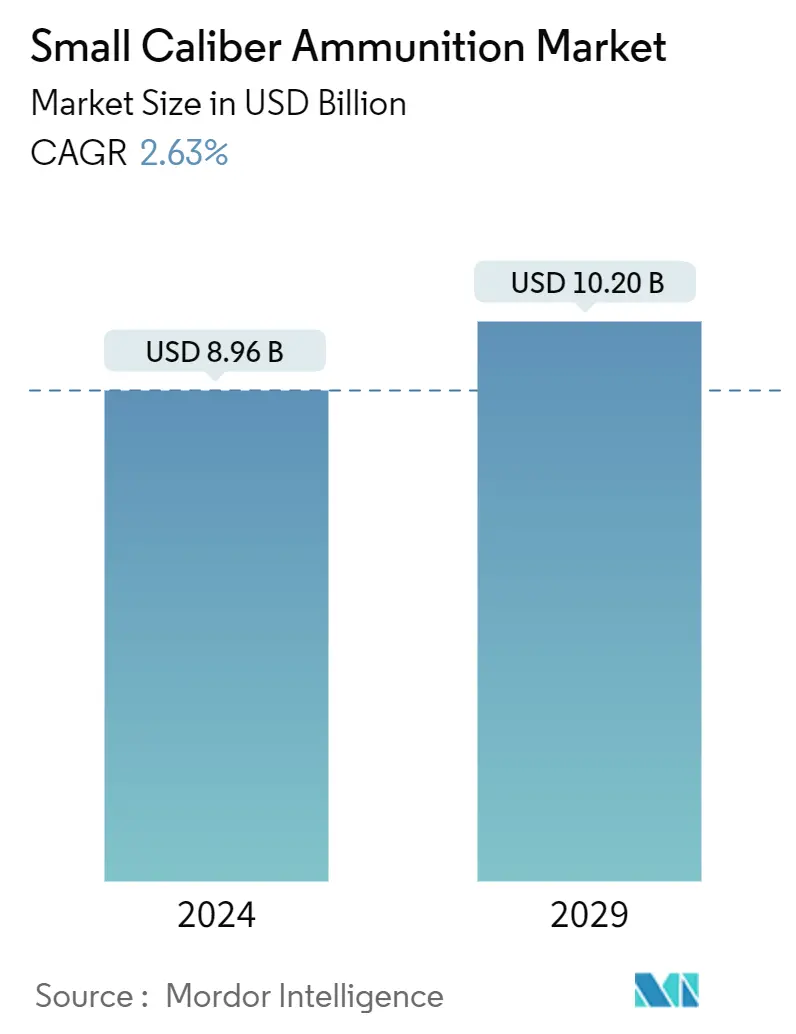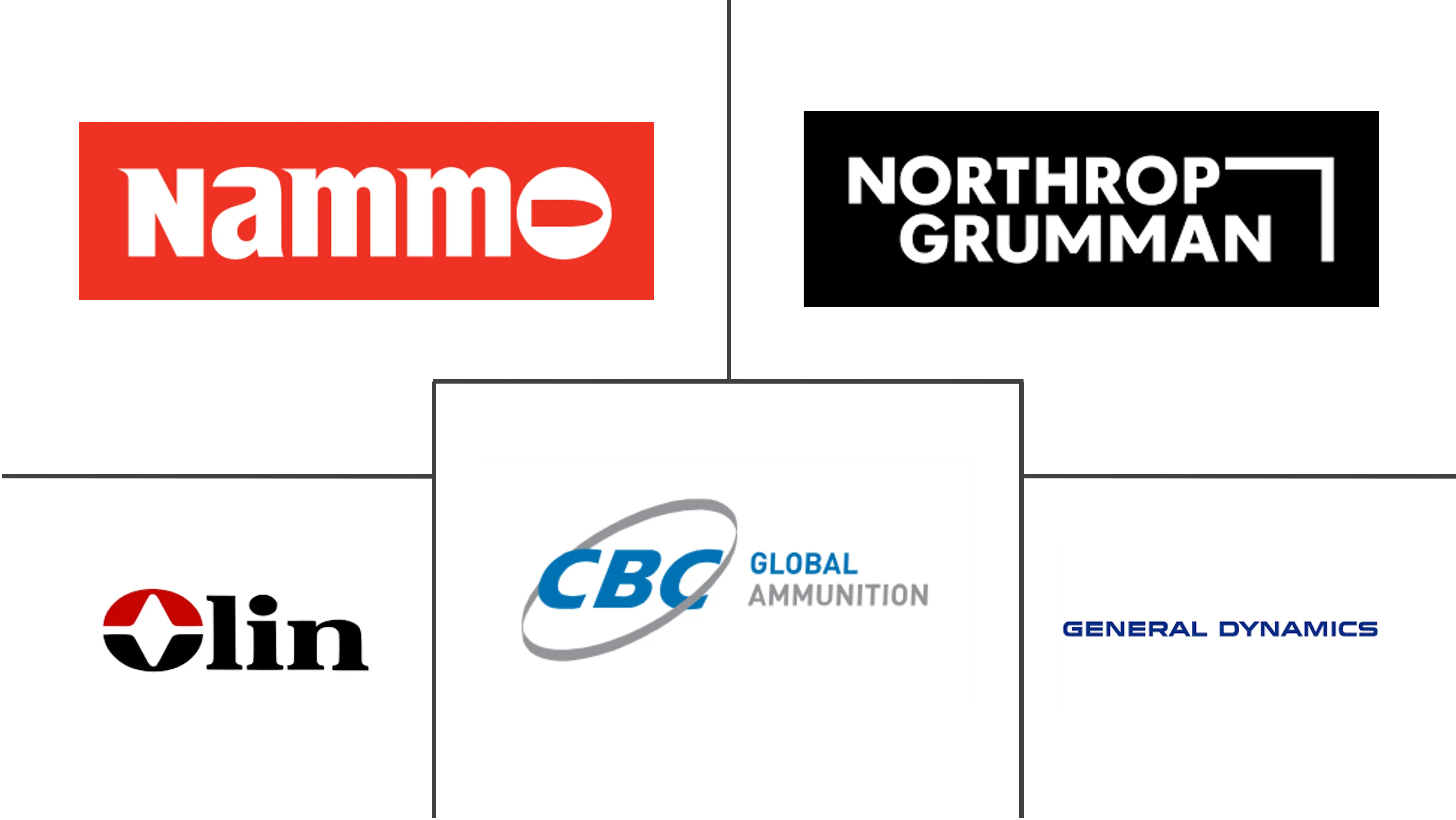
| Study Period | 2019 - 2029 |
| Market Size (2024) | USD 8.96 Billion |
| Market Size (2029) | USD 10.20 Billion |
| CAGR (2024 - 2029) | 2.63 % |
| Fastest Growing Market | Europe |
| Largest Market | North America |
| Market Concentration | Low |
Major Players
*Disclaimer: Major Players sorted in no particular order |
Small Caliber Ammunition Market Analysis
The Small Caliber Ammunition Market size is estimated at USD 8.96 billion in 2024, and is expected to reach USD 10.20 billion by 2029, growing at a CAGR of 2.63% during the forecast period (2024-2029).
Procurement for the training of personnel by military and law enforcement is the constant source of demand for small ammunition. At the same time, border disputes, threats from militants and terrorists, as well as mobs are the major factors driving the underlying demand for small-caliber ammunition across all nations.
The growth of the small caliber ammunition market is subjective to several associative factors, such as the allocation of funds for the procurement of new equipment. It may be adversely affected by rapid technological advances resulting in the effective life of newly developed technology. Increasing investments in defense for military modernization programs to procure better equipment to replace its existing arsenal is also acting as one of the key market drivers of the small-caliber ammunition market.
Furthermore, the localization of the arms and ammunition manufacturing industry countries has been catching up with great interest and enthusiasm. Governments have been imposing local production and re-investment offsets as part of most mid-to-long-term military procurements.
The illegal sales of small caliber weapons and ammunition on the dark web present challenges for law enforcement agencies and governments of countries. Dark webs are those parts of obscured global networks that are frequently visited by criminals and other types of individuals to procure or sell a wide range of weapons and associated ammunition through encrypted marketplaces and vendor shops. The high level of anonymity enabled by the dark web makes the identification and linking of individuals to specific activities extremely challenging.
The stringent laws on gun ownership act as a key restrain for the growth of the small caliber ammunition market during the forecast period. The growing emphasis on gun control measures to reduce accidental gun deaths and injuries, domestic violence-related deaths, homicides, and suicides may even make the licensed rifle purchasing processes difficult during the upcoming period. This is expected to deter the growth of the market during the forecast period.
Small Caliber Ammunition Industry Segmentation
The small caliber includes the range of ammunition in production and deployment that are below .50 caliber (12.7 mm), including 5.56 mm, 7.62 mm, 9 mm, 10- and 12-gauge, .22 caliber, .30 caliber, .38 caliber, .45 caliber, and .300 Winchester Magnum (WinMag). The report also includes ammunition used by military personnel and civilians. The military segment includes procurements by the military (army, navy, and air force), homeland security, local law enforcement agencies, border security forces, and special forces.
The small caliber ammunition market is segmented by end-user and geography. By end-user, the market is segmented into civilian and military. The report also covers the market sizes and forecasts for the small caliber ammunition market in major countries across different regions. For each segment, the market size is provided in terms of value (USD).
| Civilian |
| Military |
| North America | United States |
| Canada | |
| Europe | United Kingdom |
| France | |
| Germany | |
| Russia | |
| Rest of Europe | |
| Asia-Pacific | China |
| India | |
| Japan | |
| South Korea | |
| Rest of Asia-Pacific | |
| Latin America | Brazil |
| Mexico | |
| Rest of Latin America | |
| Middle East and Africa | Saudi Arabia |
| United Arab Emirates | |
| Egypt | |
| Rest of Middle East and Africa |
Small Caliber Ammunition Market Size Summary
The small caliber ammunition market is poised for steady growth over the forecast period, driven by persistent demand from military and law enforcement sectors for training and operational purposes. This demand is further fueled by geopolitical tensions, border disputes, and threats from militant groups, which necessitate increased defense spending and military modernization programs. The market is also influenced by the localization of arms manufacturing, with governments encouraging domestic production to bolster local economies and reduce reliance on foreign suppliers. However, the market faces challenges from illegal sales on the dark web, which complicate regulatory efforts and pose security risks. Additionally, stringent gun control laws in various regions act as a restraint, potentially limiting market expansion by making firearm acquisition more difficult.
The market landscape is characterized by a mix of local and global players, with significant contributions from countries like the United States, India, and those in NATO, which benefit from inter-member demand. The United States, in particular, is investing heavily in advanced weapon systems and ammunition to maintain its military edge and support international missions. Meanwhile, countries such as India are developing new calibers to enhance their military capabilities. The market's fragmentation is evident in the presence of numerous manufacturers, both local and international, who cater to specific regional demands and collaborate on defense projects. Despite these challenges and dynamics, the market is expected to maintain a positive trajectory, supported by ongoing defense investments and the need for robust military preparedness.
Small Caliber Ammunition Market Size - Table of Contents
1. MARKET DYNAMICS
- 1.1 Market Overview
- 1.2 Market Drivers
- 1.3 Market Restraints
-
1.4 Porters Five Forces Analysis
- 1.4.1 Threat of New Entrants
- 1.4.2 Bargaining Power of Buyers/Consumers
- 1.4.3 Bargaining Power of Suppliers
- 1.4.4 Threat of Substitute Products
- 1.4.5 Intensity of Competitive Rivalry
2. MARKET SEGMENTATION
-
2.1 End-Use
- 2.1.1 Civilian
- 2.1.2 Military
-
2.2 Geography
- 2.2.1 North America
- 2.2.1.1 United States
- 2.2.1.2 Canada
- 2.2.2 Europe
- 2.2.2.1 United Kingdom
- 2.2.2.2 France
- 2.2.2.3 Germany
- 2.2.2.4 Russia
- 2.2.2.5 Rest of Europe
- 2.2.3 Asia-Pacific
- 2.2.3.1 China
- 2.2.3.2 India
- 2.2.3.3 Japan
- 2.2.3.4 South Korea
- 2.2.3.5 Rest of Asia-Pacific
- 2.2.4 Latin America
- 2.2.4.1 Brazil
- 2.2.4.2 Mexico
- 2.2.4.3 Rest of Latin America
- 2.2.5 Middle East and Africa
- 2.2.5.1 Saudi Arabia
- 2.2.5.2 United Arab Emirates
- 2.2.5.3 Egypt
- 2.2.5.4 Rest of Middle East and Africa
Small Caliber Ammunition Market Research FAQs
How big is the Small Caliber Ammunition Market?
The Small Caliber Ammunition Market size is expected to reach USD 9.20 billion in 2025 and grow at a CAGR of 2.63% to reach USD 10.47 billion by 2030.
What is the current Small Caliber Ammunition Market size?
In 2025, the Small Caliber Ammunition Market size is expected to reach USD 9.20 billion.


